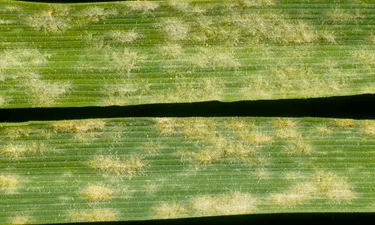
Powdery Mildew
Yield losses of 10% to 15% resulting from powdery mildew in barley are common, but losses can be as large as 40%. Grain filling is reduced, leading to shriveled grain and a poor sample.

Yield losses of 10% to 15% resulting from powdery mildew in barley are common, but losses can be as large as 40%. Grain filling is reduced, leading to shriveled grain and a poor sample.
What is Powdery Mildew?
Powdery mildew can only grow on green plants. It survives the harvest period on late tillers, releasing spores that are spread by the wind to infect the new crop. Favourable factors for powdery mildew include warm (12º to 20ºC) and humid (but not raining) weather, and wind aids its spread. Temperatures above 25ºC will check disease spread. Rapidly growing, thick crops provided with high levels of nitrogen are most vulnerable, particularly in susceptible varieties.
How to spot Powdery Mildew
White fluffy pustules appear on the leaves, the stem and on the ear. The pustule can easily be rubbed off and the tissue is discoloured brown underneath. With time the pustule itself turns brown and black spore cases called picnidia can be seen embedded in the fungus.
Occasionally a reaction called hypersensitivity occurs on barley varieties with a high resistance rating. The symptoms are small brown flecks with no evidence of mildew pustules. The reason for this is that the infective mildew spores germinate on the leaf and begin to infect the plant. The host tissue dies and the mildew no longer has living material to grow in and a small brown lesion results. It is also possible that fungicidal phoenolics are generated by the dying tissue.
How to control Powdery Mildew
Correct use of fungicides combined with choice of variety will give excellent control throughout the growing periods.
If the disease becomes established in young winter barley plants during winter then consider a T0 application of a specific mildewicide such as Torch (spiroxamine).
If in a protectant situation then prothioconazole is the most effective of the azoles against this diease, an application of Fandango (prothioconazole + fluoxastrobin) or SiltraXpro (prothioconazole + bixafen) as part of your usual disease control programme should take care of all but the most severe infections. Always consider the addition of a specific mildewicide throughout the programme in cases of established infection.


